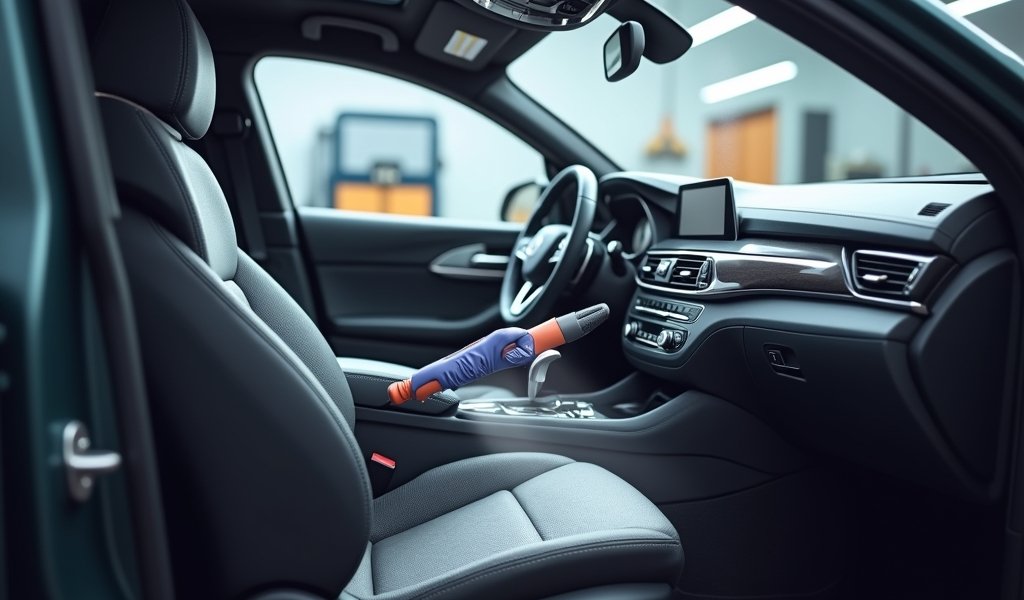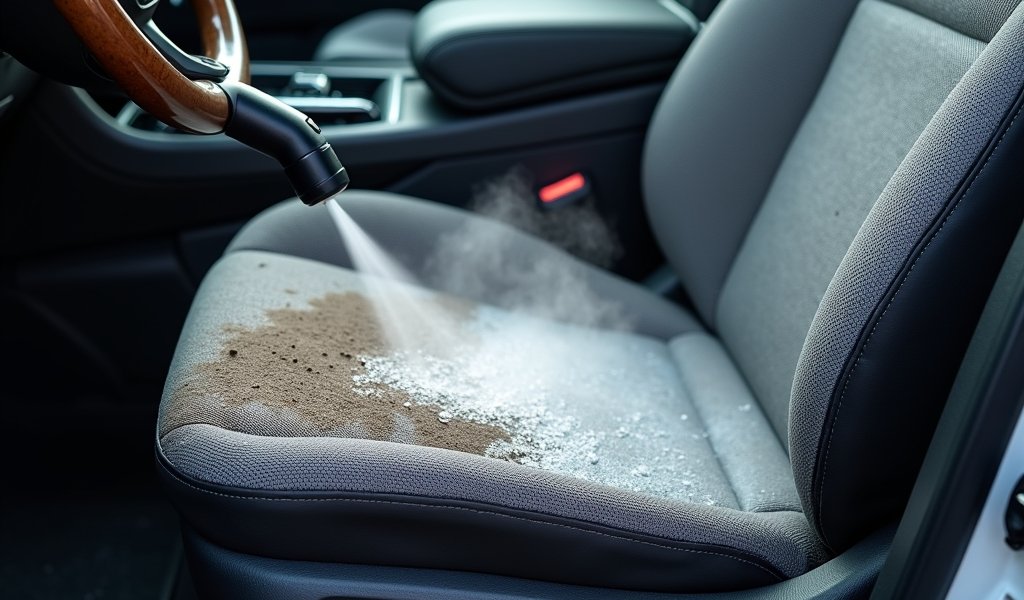Overview
Steam cleaning car interiors provides a chemical-free, deep-cleaning alternative that sanitizes surfaces, eliminates odors, and removes stubborn stains while being gentler on materials than traditional cleaning products. The article recommends specific steam cleaners for different needs, proper cleaning techniques for various interior surfaces, and maintenance tips both for the cleaner and the car interior to maximize effectiveness and prevent damage.
Table of Contents
- Why Steam Clean Your Car Interior?
- Benefits of Steam Cleaning for Vehicle Interiors
- Key Features to Look for in a Car Interior Steam Cleaner
- Top Steam Cleaners for Car Interiors
- How to Use a Steam Cleaner on Your Car Interior
- Maintenance Tips for Your Steam Cleaner
- Common Mistakes to Avoid When Steam Cleaning
- Conclusion
- Frequently Asked Questions
Ever noticed that lingering food smell or those mysterious stains on your car upholstery that seem to appear from nowhere? Your vehicle’s interior takes a daily beating, but there’s a hero in the cleaning world that deserves more recognition: the steam cleaner. As a mechanic who’s seen thousands of car interiors, I can tell you that the best steam cleaner for car interior cleaning can transform even the most neglected vehicle into a spotless sanctuary.
Steam cleaning isn’t just another cleaning method—it’s a complete game-changer. Using nothing but the power of heated water, these machines blast away dirt, kill germs, and reach those frustratingly inaccessible corners that seem to attract crumbs like magnets. Having worked on vehicles of all conditions at our shop, I’ve seen firsthand how proper interior maintenance not only improves your driving experience but also helps maintain your vehicle’s value over time.
Why Steam Clean Your Car Interior?
Traditional car cleaning products can actually harm your vehicle’s interior over time. Many chemical cleaners leave behind residues that gradually break down materials and often just mask odors rather than eliminating them. As someone who works with cars daily, I’ve seen too many interiors damaged by harsh cleaning chemicals.
Steam cleaning, however, works differently. It uses water heated to approximately 212°F, creating steam that sanitizes surfaces by killing 99.9% of bacteria and germs without a single drop of chemicals. This makes it ideal for those with allergies or chemical sensitivities who want to breathe easier during their commute.
Different surfaces in your vehicle respond excellently to steam cleaning:
- Fabric upholstery releases stains that have been stubbornly set for months
- Leather seats get a deep clean without drying out (when done correctly)
- Plastic dashboards and trim shine like new without greasy residue
- Carpet and floor mats surrender deeply embedded dirt you didn’t even know was there
The real beauty of investing in a quality steam cleaner lies in its long-term value. While professional interior detailing services typically cost between $150-$300 per session, your own steam cleaner pays for itself after just a few uses. Plus, you’ll have the satisfaction of knowing every inch of your car has been cleaned to your standards.
Benefits of Steam Cleaning for Vehicle Interiors

Having worked on thousands of vehicles over my career, I can confidently say that steam cleaning offers benefits that no other cleaning method can match:
- Chemical-free cleaning: Steam uses only water, making it environmentally friendly and safe for everyone in your vehicle
- Deep sanitization: The high temperature kills dust mites, bacteria, and even mold spores lurking in your upholstery
- Odor elimination: Rather than masking smells, steam eliminates the source of odors by removing the bacteria causing them
- Stain removal: Steam penetrates deep into fibers to lift stains that surface cleaners can’t touch
- Reduced drying time: When used correctly, steam cleaning leaves surfaces only slightly damp, meaning faster drying compared to shampooing
According to research published in the Journal of Environmental Health, steam cleaning can eliminate up to 99.9% of common bacteria and pathogens. This makes it particularly valuable for families with young children or individuals with compromised immune systems who need their vehicles to be more than just visually clean.
As a mechanic, I’ve noticed that customers who regularly steam clean their interiors tend to report fewer allergy symptoms while driving. The removal of allergens like dust mites, pollen, and pet dander creates a healthier environment for everyone.
Key Features to Look for in a Car Interior Steam Cleaner
Not all steam cleaners are created equal, and choosing the wrong one can lead to disappointment or even damage. Here’s what I recommend looking for based on years of experience working with these tools:
Pressure and Temperature
The effective combination for car interiors is both heat and pressure. Look for units that reach at least 200°F with pressure between 40-58 PSI. This range ensures you’re actually deep cleaning rather than just wetting surfaces.
Size and Portability
Your steam cleaner should be compact enough to maneuver easily around your vehicle’s interior. Models weighing between 8-12 pounds typically offer a good balance between stability and portability, making it easier to reach across seats and into footwells.
Specialized Attachments
The difference between an adequate cleaning job and an exceptional one often comes down to having the right tools:
- Pointed nozzles for vents and tight crevices
- Brush attachments for agitating stubborn stains
- Upholstery tools with microfiber covers for delicate surfaces
- Extension wands for reaching under seats without contortion
Tank Capacity and Heating Time
Look for a capacity that balances portability with practical use time—typically 40-48 oz is ideal for most vehicles. A unit that heats up in under 8 minutes will keep your cleaning momentum going, while those requiring 15+ minutes might test your patience.
Cord Length and Hose Reach
A generous cord length of at least 15 feet gives you the freedom to circle your vehicle without constant unplugging. Similarly, a steam hose of 5+ feet allows you to reach the far corners of larger vehicles like SUVs and minivans without constantly moving the base unit.
Top Steam Cleaners for Car Interiors
After testing dozens of models throughout my career, these five steam cleaners consistently deliver exceptional results for automotive interiors:
Best Overall: McCulloch MC1275 Heavy-Duty Steam Cleaner
The McCulloch combines powerful 58 PSI steam output with a generous 48 oz tank that provides up to 45 minutes of continuous steam. With 18 included accessories, you’re never without the right tool for any car interior challenge. At around $139, it hits the sweet spot between professional performance and consumer affordability.
Best Budget Option: PurSteam Handheld Pressurized Cleaner
Don’t let its compact size fool you—this little powerhouse heats up in just 3-4 minutes and delivers impressive cleaning power for its $39.99 price tag. It’s perfect for spot cleaning and quick refreshes between more thorough DIY detailing sessions.
Premium Choice: Dupray Neat Steam Cleaner
For those serious about interior maintenance, the Dupray Neat justifies its $189 investment with superheated steam (up to 275°F), a massive 50-minute run time, and build quality that suggests it will outlast your current vehicle. Its digital control panel and retractable handle add convenience that makes the premium price easier to swallow.
Best Portable Model: Bissell SteamShot Deluxe
Weighing just 3 pounds but delivering impressive results, the SteamShot excels at quick cleaning sessions. Its $49.99 price point makes it accessible for most car owners, while the quick 30-second heat-up time means you can address spills before they become permanent features of your interior.
Best Multipurpose Option: HomeRight SteamMachine
This versatile performer transitions seamlessly from cleaning kitchen grout to revitalizing car upholstery. With 1500 watts of power, 40-45 PSI steam pressure, and a comprehensive attachment set for $149, it’s the practical choice for households that want one solution for multiple cleaning environments.
How to Use a Steam Cleaner on Your Car Interior

All the cleaning power in the world won’t help if your technique isn’t right. Here’s my professional approach after years of restoring vehicle interiors:
Preparation Steps
- Declutter and vacuum first—steam cleaning works best on surfaces already free of loose debris
- Remove floor mats and clean them separately outside the vehicle
- Open all doors and windows for proper ventilation and faster drying
- Check manufacturer recommendations for any surfaces with specific cleaning limitations
- Fill your steam cleaner with distilled water if you live in an area with hard water to prevent mineral buildup
Techniques for Different Surfaces
For Fabric Upholstery: Start with a microfiber attachment and work in small, overlapping sections. Hold the steamer about two inches from the surface and move slowly to allow heat penetration. For stubborn stains, gently brush the area while steaming to agitate the fibers.
For Leather: Use extreme caution with leather surfaces. Keep the steamer moving constantly, never holding it in one place. Use the lowest effective pressure setting and follow immediately with a clean microfiber cloth to remove moisture. Once dry, apply an appropriate leather conditioner to restore natural oils.
For Plastic and Vinyl: These durable surfaces can generally handle direct steam, but avoid lingering too long on any decorative elements or electronic control panels. Use a pointed nozzle to target dirt-collecting seams and crevices around buttons.
Special Attention Areas
Those cup holders that seem to collect sticky residue from every drink ever transported deserve special attention. Direct steam into these areas, then immediately wipe with a microfiber cloth. For air vents, a gentle blast of steam followed by compressed air creates a one-two punch that expels dust without pushing it further into your ventilation system.
The area around seat tracks often contains forgotten items and mysterious debris—use extension tools to reach these areas without removing the seats. As someone who details cars professionally, I can tell you these hidden areas make a surprising difference in eliminating persistent odors.
Drying and Post-Cleaning Care
Proper drying is crucial to prevent that musty smell that comes from lingering moisture. After steam cleaning:
- Leave doors open for at least 30 minutes to promote air circulation
- Consider using a fan to accelerate drying in humid climates
- For fabric surfaces, gently blot (don’t rub) with clean, dry microfiber towels
- Apply appropriate protectants once surfaces are completely dry
Maintenance Tips for Your Steam Cleaner
Like your vehicle, your steam cleaner requires regular maintenance to perform at its best. Here’s how to keep it in top condition:
Proper Storage
Always empty and dry the tank completely before storage to prevent mineral buildup and potential mold growth. Store in a cool, dry place with attachments organized nearby—nothing dulls cleaning enthusiasm like hunting for that one perfect nozzle you need.
Cleaning After Use
Mineral deposits are the silent killer of steam cleaners. Flush the system monthly with a mixture of white vinegar and water (1:1 ratio) to dissolve any buildup, followed by two clear water rinses. According to Penn State Extension research, this simple maintenance step can extend your machine’s life by years.
Attachment Care
Brushes and cloths take the brunt of the cleaning action. Rinse brushes thoroughly after use and machine wash microfiber attachments separately from other laundry. Allow all attachments to dry completely before storage to prevent mildew growth that could transfer to your vehicle on the next use.
When to Replace Parts
Even the best attachments eventually wear out. Bristles that splay outward, torn microfiber covers, or any sign of melting or warping indicate it’s time for replacement. Most manufacturers sell individual attachments, saving you from purchasing an entirely new unit.
Common Mistakes to Avoid When Steam Cleaning
In my years of automotive work, I’ve seen plenty of well-intentioned cleaning efforts go wrong. Avoid these common pitfalls:
Using Too Much Pressure on Delicate Surfaces
Headliners and leather are particularly vulnerable to damage from excessive steam pressure. Always start with the lowest effective setting and increase gradually only if necessary. I’ve seen headliners completely separate from their backing due to overzealous steam cleaning.
Not Testing in Inconspicuous Areas First
That hidden section under the seat isn’t just collecting dust—it’s your perfect testing ground to ensure your steam cleaner won’t cause discoloration or damage to materials. This five-second test can save you from ruining visible upholstery.
Oversoaking Materials
Steam should dampen, not soak. Excessive moisture can penetrate to padding beneath upholstery, creating perfect conditions for mold growth and unpleasant odors. Keep the steamer moving and follow with dry cloths to remove excess moisture.
Improper Heat Management
Steam burns are serious, and melted plastic from setting down a hot nozzle on your car’s interior creates permanent damage. Always use heat-resistant surfaces for resting the steamer and be mindful of where the steam is directed—including away from your hands and electronics.
Conclusion
A quality steam cleaner is one of the smartest investments you can make for maintaining your vehicle’s interior. By focusing on the right features, choosing a model that fits your specific needs, and applying proper techniques, you’ll extend the life of your car’s interior while creating a healthier environment for every journey.
Steam cleaning isn’t just about appearances—it’s about preserving your car’s value and creating a more pleasant driving experience. With regular steam cleaning, you’ll eliminate odors, remove stains, and maintain that “almost new” feeling that makes every drive more enjoyable.
As a mechanic who sees the difference between well-maintained and neglected interiors daily, I can tell you that this simple maintenance practice makes a world of difference in how your vehicle ages. Your car’s interior is where you spend countless hours—doesn’t it deserve to be as clean and healthy as possible?
Frequently Asked Questions
Is steam cleaning safe for all car interior surfaces?
Steam cleaning is safe for most surfaces when used correctly, but caution is needed with electronics, untreated leather, and delicate headliners. Always test in an inconspicuous area first and use the appropriate attachments for different materials.
How often should I steam clean my car interior?
For average use, steam clean your car interior every 3-4 months for maintenance. Increase frequency to monthly if you have pets, children, or frequently eat in your vehicle.
Can steam cleaning remove deeply set stains?
Yes, steam cleaning can remove many deeply set stains by penetrating fibers and breaking down the stain molecules. For particularly stubborn stains, multiple gentle applications work better than one aggressive attempt.
Will steam cleaning damage leather seats?
When done correctly with low pressure and constant movement, steam cleaning won’t damage quality leather. Always follow with a leather conditioner after cleaning and drying to replace natural oils.
Can I use tap water in my car steam cleaner?
Distilled water is strongly recommended to prevent mineral buildup in your steam cleaner. Tap water, especially in hard water areas, can shorten your machine’s lifespan and potentially leave mineral residue on surfaces.

